For more than two decades, Aussie amateurs have been taking it to the world’s best. Now we have a few pros of our very own
Words Peter Whitaker Photography AMCN archives
The Dakar Rally may well have remained beyond Aussie horizons had not Hans Tholstrup and Tom Snooks devised the Wynn’s Sydney to Darwin Safari in 1985, creating a generation of hard-core Australian cross-country racers.
Among many others, Dakar champions Gaston Rahier, Cyril Neveu and Edi Orioli all travelled Down Under to contest the Wynn’s Safari but were found wanting, so we naively believed our outback was just as tough as anything in Africa. When South Australian Andy Haydon won the 1997 Australian Safari his reward was a ticket to Paris and an entry to Dakar. Now we’d show those French a thing or two.
Not Quite. Stéphane Peterhansel won his sixth Dakar but, as Andy Haydon recalls, “Fabrizio Meoni and I scored KTM’s first Dakar podiums. Aussie Andy Coaker came third in Malle Moto (unassisted) and Simon Pavey finished top 50. It was the first time any Australian had competed so it was a great result.”
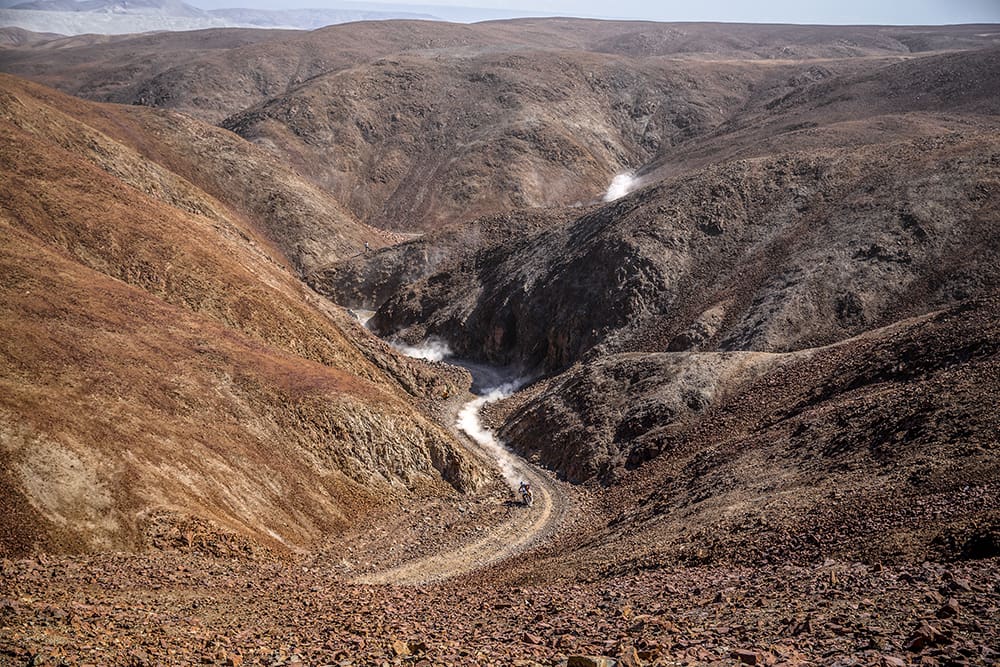
What Haydon fails to mention is that, unlike Meoni’s KTM 640, his bike was a superseded kick-start model. Or that he won two of the longest competitive stages in Dakar history, 680km and 745km, both across the Western Sahara Desert. These pioneering efforts were truly inspiring and Australia has been represented in Dakar every year since.
After four consecutive wins in the Australian Safari, Andy Caldecott headed to Dakar, only to break an ankle in Morocco. Together with his close mate Dave Schwarz, he returned in 2005 to ride a KTM 660 built by KTM Crew Chief, Aussie Lee Palmer. But if sixth outright was the best our undisputed king of the desert could achieve, the Dakar was obviously tougher than we thought.
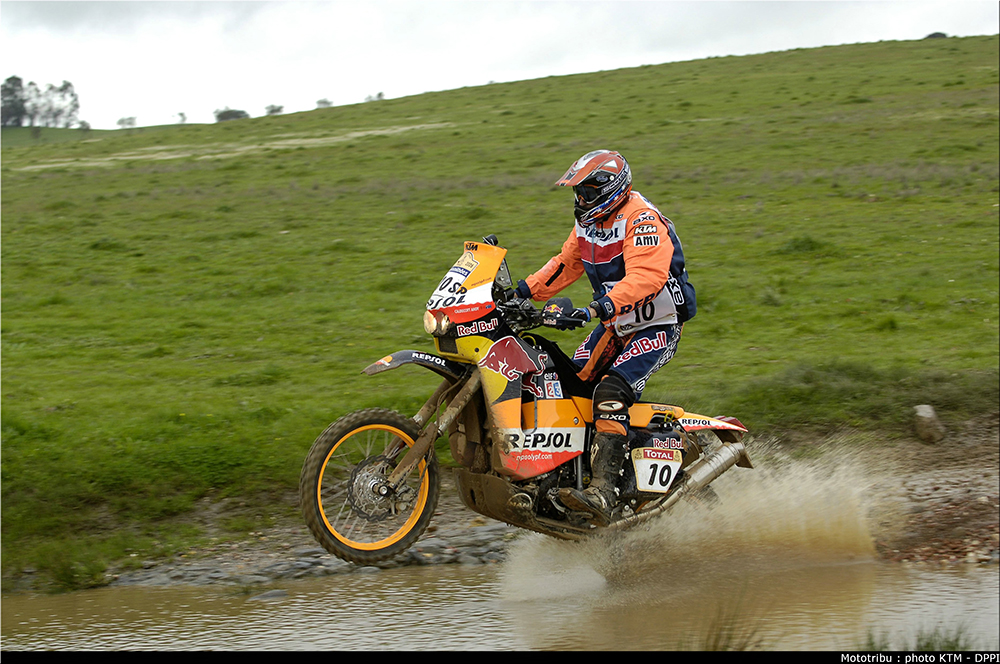
Andy Caldecott was a trailblazer in the event, competing for three years
Dave Schwarz, who’d finished 37th outright and an outstanding third in the 450cc Division, recalls sitting with Andy on the beach at Lac Rose.
“We were feeling pretty pleased when Andy posed the rhetorical question ‘Do you think anyone at home really understands what we’ve achieved?’” In the era before instant digital vision at the click of a button, few of us watching the highlights had any idea.
In 2006, Caldecott took a late call as a replacement for an injured Meoni and, despite not being match fit, claimed a stage win before his fatal accident in Morocco. Dakar addicts such as Simon Pavey and Christophé Barriere-Varju kept returning, but rookie Mark Eland spent the best part of $70K for a Medivac and an even more expensive hospitalisation when he finally made it back home.

A crash in the 2006 Dakar cost the four-time Safari winner his life
The direct threat of terrorism may have forced the Amuary Sport Organisation’s (ASO) hand, but severing the entire Dakar circus from its Eurocentric origins was an inspired decision. Regular European entrants were delighted to head south for the winter, American based teams found the budget to head south from Baja and, to everyone’s delight, the entire populations of Argentina and Chile embraced the spectacle.
For Australians, crossing the Pacific in summer was far easier than the kangaroo hop to a European winter, though Dave Schwarz was the only Aussie to head to Buenos Aires in 2009. The following year Christophé Barriere-Varju won a well-deserved Malle Moto podium.
In 2011, Australia’s most successful cross-country team – Glenn Hoffmann Racing – plugged 22-year-old Australian Safari champion Jake Smith into the mix on a meticulously prepared Honda CRF450X. With a specially built backup truck, veteran Dakar spannerman Max Sullivan and a well-disciplined team, Hoffmann was anticipating a top 10 result.
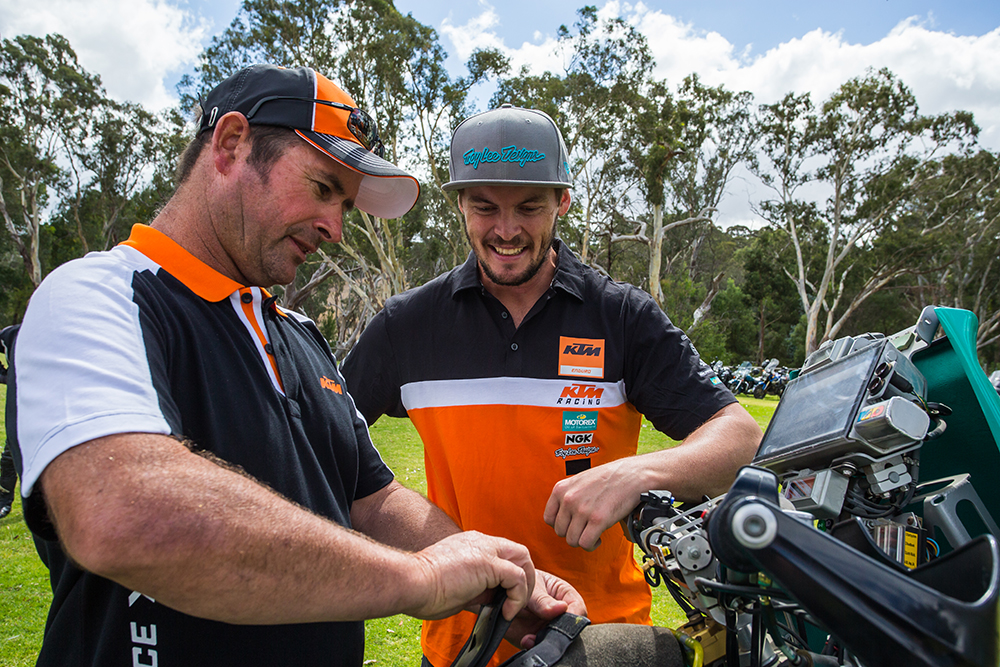
Andy Haydon and Toby Price in 2015
“In any race, small problems can become big problems,” said the usually taciturn Hoffmann. “But in the Dakar they become insurmountable and the downward spiral is exponential.”
That just about sums up Jake’s ride, though he did persevere to the finish.
“It’s the hardest thing I’ve done in my life; so physically and mentally tiring I just wanted to give up,” he said. “I’m not an emotional kind of bloke, but sometimes out there I felt like crying. It’s hard to explain how wild and insanely demanding the Dakar is but, at the same time, how addictive and rewarding.”
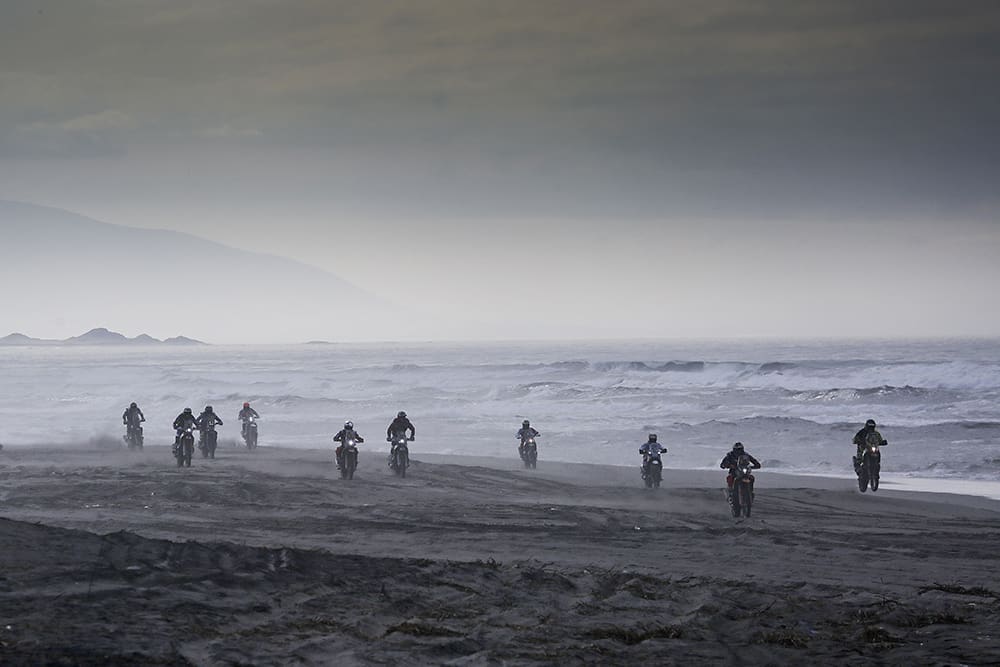
Thanks to Garry Connell’s Dakar experience and connections with Husaberg, Longreach Yamaha dealer Rod Faggotter had a great shot at a top 20 position in 2012 before engine failure stopped his run, though teammate Dave Schwarz was awarded his third Dakar Finisher’s Medallion. West Aussies Dean Nuttall and Jamie Chittick also celebrated becoming the 10th and 11th Australians respectively to finish a Dakar.
With a total of nine entries (10 if you include Kiwi Brett Cummings), 2013 was a watershed year for Australians. Finally KTM Australia had provided some support to multi-time Australian Safari and Finke Desert Race champion Ben Grabham with a production KTM450. If anyone was capable of cracking a top 10, surely it was Grabbo.

Rod Faggotter during Stage 9 of the 2020 event
“Our objective was simply to see what needs to be done to run at the pointy end,” he explains. “We just wanted to finish so we could put into practice what we learnt.”
Despite losing a few parts from the rear master cylinder and riding 340km with no rear brake, Grabbo managed the second-best finish for an Aussie since Andy Caldecott.
The best went to Faggotter, who forked out for a YZ450F-based Rallye from French-based Yamaha HFP Team. Starting way back, Rod made up 50 positions to finish first of the privateers and one position ahead of Grabbo.
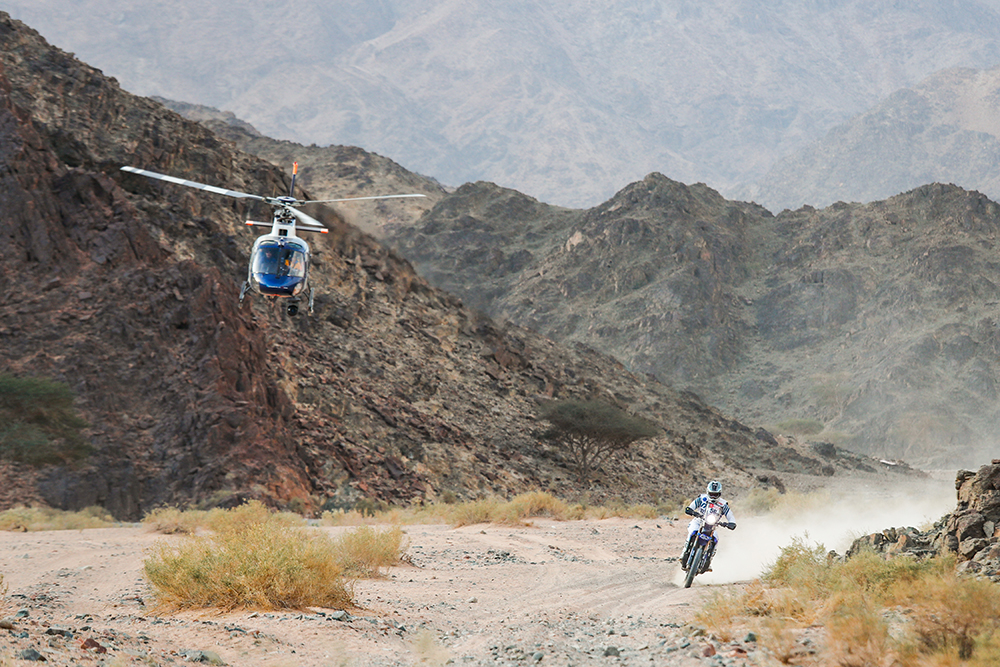
Rodney Faggotter Stage 4 of Dakar 2020
Having mixed it with both Grabham and Faggotter on many occasions in Australia, Jake’s elder brother Todd Smith figured on a similar pace in South America but a dropped valve early in the event and problems with the navigational tower pushed him back in the pack.
“We needed more work on the bike,” Todd reported. “It simply didn’t have the balls for the dunes and the top speed was only 157km/h with the wind up my arse.”
Speed was no problem for Matt Fish, who’d spent more than $50,000 demonstrating his skills in the Abu Dhabi and Qatar Desert Races in order to secure a Dakar berth as water boy to Joan Barreda on the Speedbrain Factory Team. Fish demonstrated both he and his Husqvarna were up to the task by being the first Australian to win a Dakar Prologue, and backed it up with a Stage podium. All this really meant is that Barreda didn’t lose too much time when he commandeered Matt’s wheel and fuel pump. Yet Matt finished, and was on the short list for selection in 2014 before he pulled the pin.
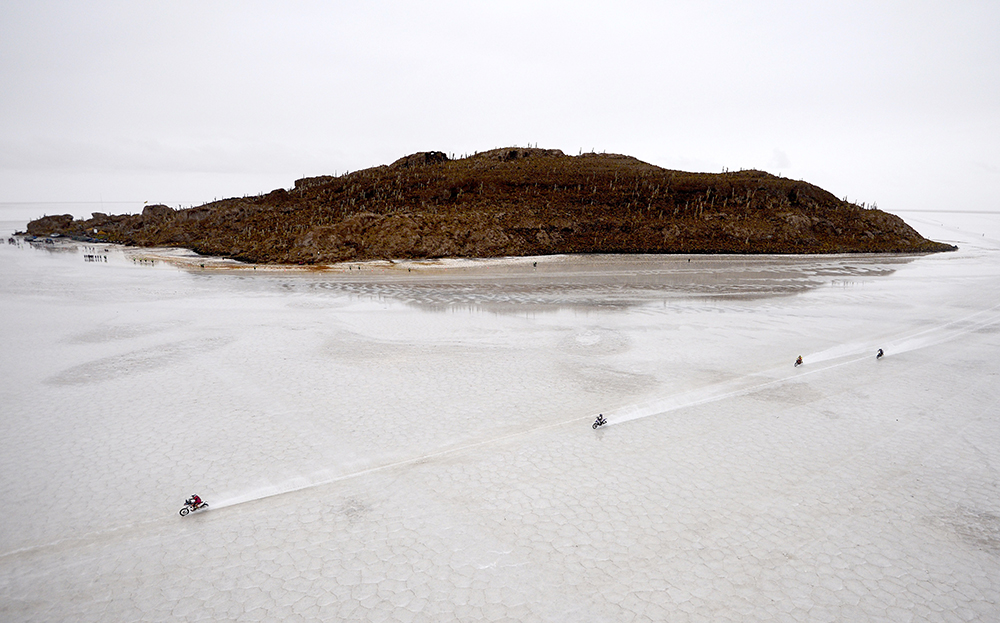
Dakar’s move to South America brought some amazing sights, like this from Stage 8 in 2015
Just to demonstrate some really true grit, 48-year-old Warren Strange spent 2012 criss-crossing Australia’s toughest tracks such as the Simpson Desert’s French Line and the Canning Stock Route on a Honda CRF450. A total of 45,000 kilometres of practice for his second attempt at Dakar and a top-30 finish.
The only Aussie not to finish was Blackbutt Hotel publican Troy O’Conner, star of Dakar’s worldwide TV highlights with his ‘Crash of the Day’ on Stage Three. After this, Troy should have heeded the advice of former Dakar champion Jacky Ickx: “If you’re going to DNF, do so early. It avoids a lot of pain.”
Instead Troy persevered and, having survived into the second week, suffered a DNF with Buenos Aires just over the horizon. Now with a score to settle, Troy was back in 2014 to finish one position behind Dakar Challenge winner Shane Diener and one up on world adventure rider/writer Allan Roberts.
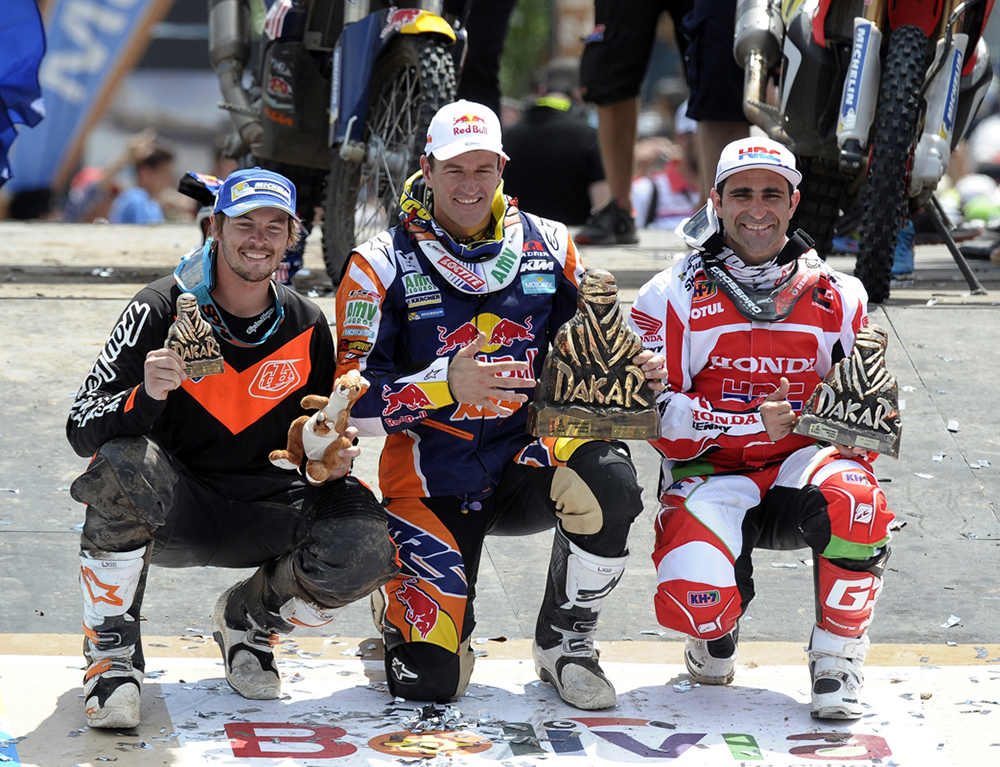
Price took his first podium in 2015, behind Marc Coma (middle) and Paulo Gonçalves
For the previous decade SBS had been broadcasting daily Dakar highlights, entrancing viewers with the the spectacle of motorcycles, four-wheel-drives and humungous trucks bouncing across mountainous sand dunes and crashing through rock strewn canyons. So when Toby Price, a bloke few viewers had heard of, finished on a stage podium of this exotic event, off-road motorcycles made the evening news for the first time in a long time.
SBS had backed a winner. Then came the spectacle on Bolivia’s Lake Uyuni which resulted in some of the most intriguing motor racing scenes ever broadcast – doubly so when our Toby was in with a chance of an outright podium.
“They were the toughest conditions of the race,” he said. “No one could avoid that salt pan and, after the refuel, there was electricity running through the bike frame which kept zapping me.”
But when the rookie came through to claim third outright, the Dakar took on an entirely different perspective for Aussie fans.
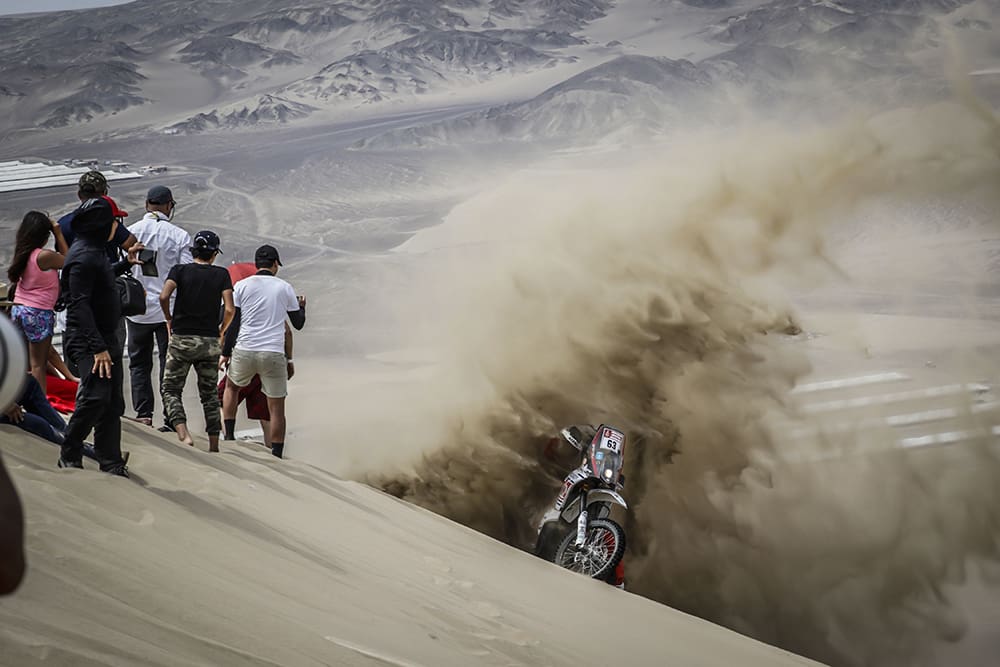
With the retirement of Cyril Despres and Marc Coma, a new generation had arrived. This was underscored by veteran Simon Pavey, who was awarded with his eighth Finisher’s Medallion while teaming up with his son Llewelyn, who won his first.
After signing a two-year deal with Red Bull KTM in July 2015 Price spent the following months finessing the finer points of navigation with Marc Coma. Instead of pleasant surprises he was now expected to run with the leaders. He didn’t disappoint. It’s rare for the rider opening the stage to contend for a podium but on Stage six, Price led out, won the day’s stage, then repeated the performance on Stage nine.
“They were two days I’m very proud of, demonstrating I could do the job alone; taking absolutely no notice of any other riders,” said Toby.
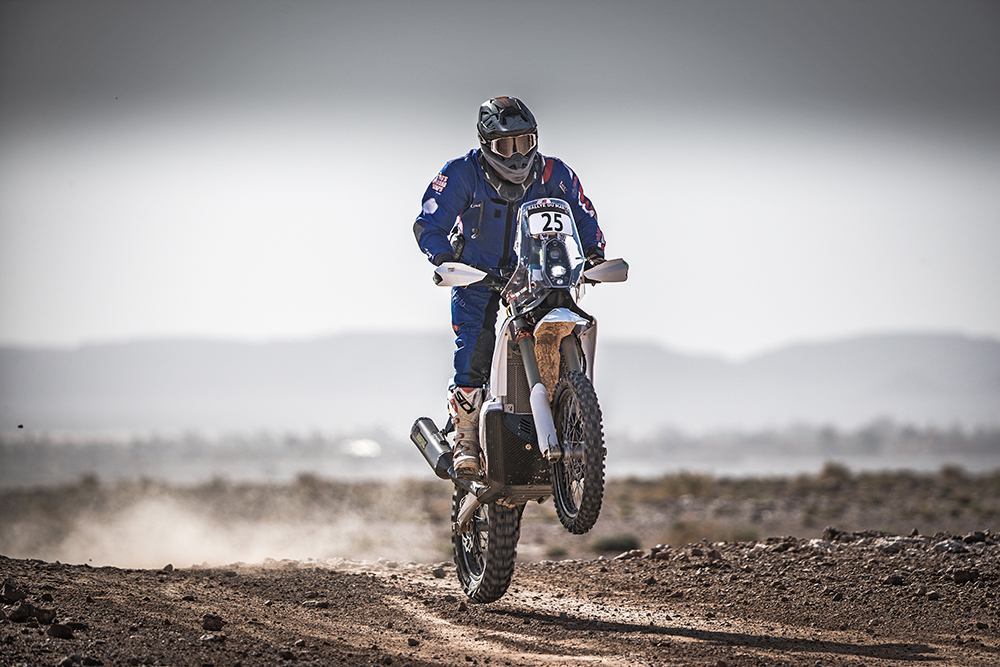
Ben Young prepared hard for the 2018 Dakar
“When I returned to the bivouac I could tell the team was as pumped as I was. Of course going on to win the Dakar was the greatest, but I doubt I’ll ever be more satisfied than when I finished Stage six.”
His victory in 2016 cemented Dakar as an annual fixture in Australian sports reporting, elevating Toby to national hero status.
While KTM Team Manager Jordi Viladoms was playing no favourites with his three young recruits Price, Sam Sunderland and Matthais Walkner, it was the Australian who had the number-one plate on his machine when they saddled up for the 2017 Dakar. This was of no consequence when, on the fourth day of his title defence, Price hit a rock buried in the riverbed.

Yamaha’s Rod Faggoter has become a regular sight on the event
Pretty much the next thing he remembers is a delighted Bolivian doctor showing him post-operation x-rays of his left femur.
“The language barrier was a bit disorienting,” recalls Toby. “And I was really glad when Rod turned up.”
Rod Faggotter, after a mechanical DNF on Stage Four, helped Price pass the time in the not-so salubrious La Paz Hospital before the pair could fly home. Meantime, Todd Smith had forsaken Honda in favour of the ubiquitous KTM 450 and consolidated a top-20 finish by riding the final few days with crushed vertebrae. A legacy that still reminds him that nothing at Dakar comes easy.
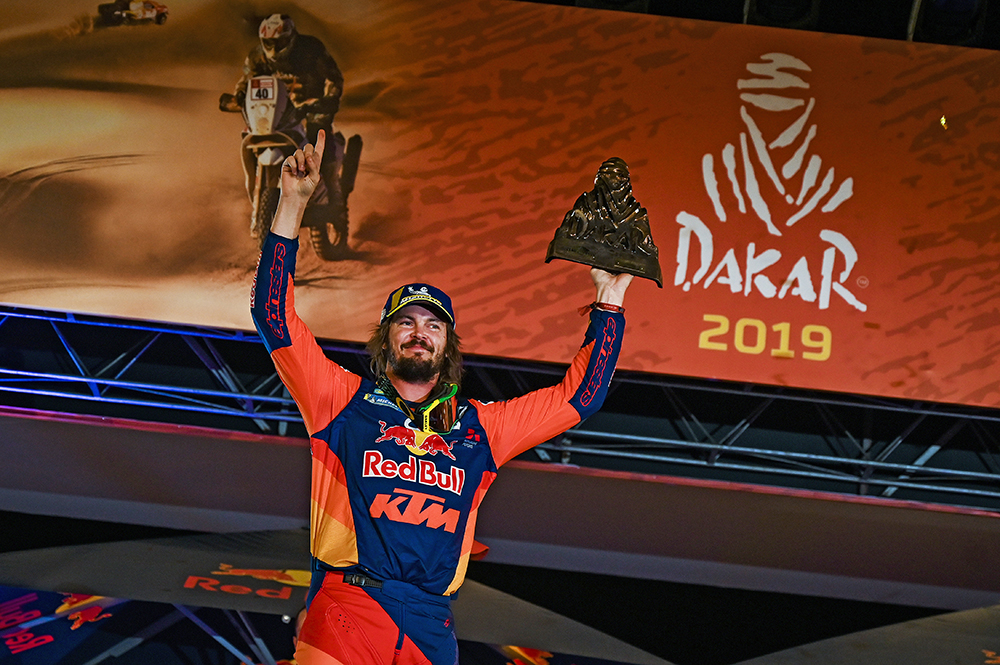
Price started the 2019 event with a broken wrist but still prevailed to take his second victory
A simple navigation error on Stage 10 relegated Price to the final step of the podium in 2018 while Faggotter outlasted all three of his professional Yamaha teammates to finish 16th. It wasn’t Rod’s best finish but he was five years older and, with a severe drought back in Longreach he’d not had much time in the saddle, let alone race preparation.
With no competition background at all, Scott Britnell established his credentials with a solo transcontinental record ride across Australia and back, following up with a record ride up the remote Canning Stock Route. By digging deep and tapping his mates he scraped together the budget to contest and finish 10th in the 2018 Malle Moto division.
If scraping together the budget to enter Dakar was proving difficult, scraping up the budget to host the event proved impossible for Argentina, Bolivia and Chile: only Peru had enough in the kitty for one more shot before the oil-rich Saudis claimed the rights for 2020 and beyond.
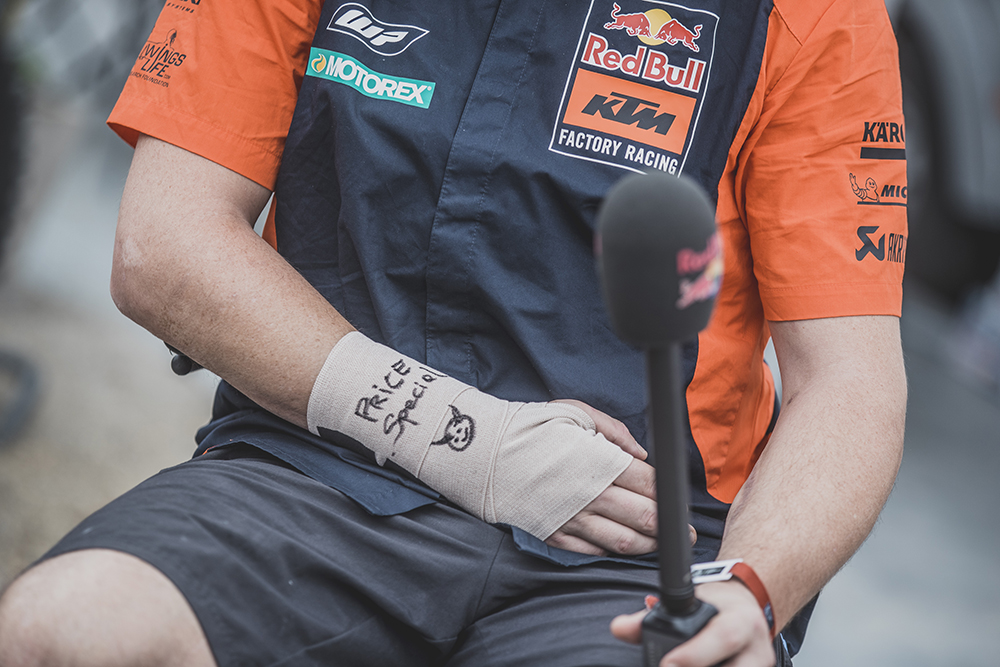
Toby Price
Regular Abu Dhabi Desert Challenge competitor Ben Young loves surfing the dunes, so when it was announced the 2019 Dakar would be held entirely in the dunes of Peru, he was in. At 47 years old, Ben qualified for the informal Veterans category where he scored a podium. Faggotter was back, but a minor technical issue caused a DNF (you have to wonder what a major technical issue would cause). Rookie James Ferguson ran a fine 11th in the unassisted category, but the news was all about Price.
The fact Toby started the Dakar with a broken wrist was news; the fact he finished the first day was news; the fact he started the second day, still with a broken wrist, was news; and so on. When he finished on the podium on Stage Four, it was big news. Not that Toby wasn’t feeling the pain, but he must have sighed with relief when the never-ending questions about his wrist ceased.
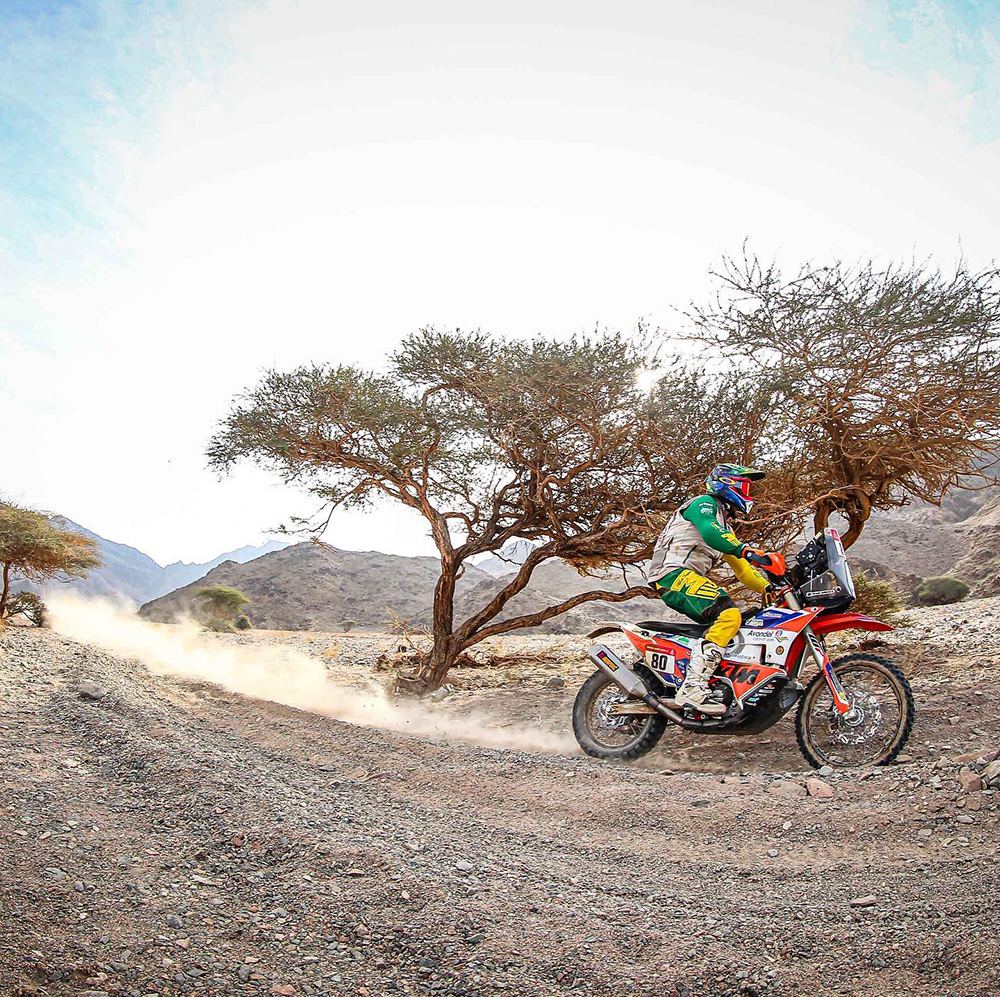
Bendigo’s Michael Burgess made his debut this year
Then, with barely another news report, let alone a Stage podium, Toby popped up third outright at the conclusion of Stage seven. A day later he was the outright leader, a position he held all the way to the finish. The only non-European to win Dakar had done it again. Regrettably Toby was in the news again the following year when he was first on the scene of Paulo Gonçalves’ tragic accident.
“I can now go home, think about it, and come back stronger in 2021,” was all he had to say.
Two deaths took much of the gloss off 43-year-old Faggotter’s best-ever result and, thanks to the support packages available, three more Aussie rookies finished the event.
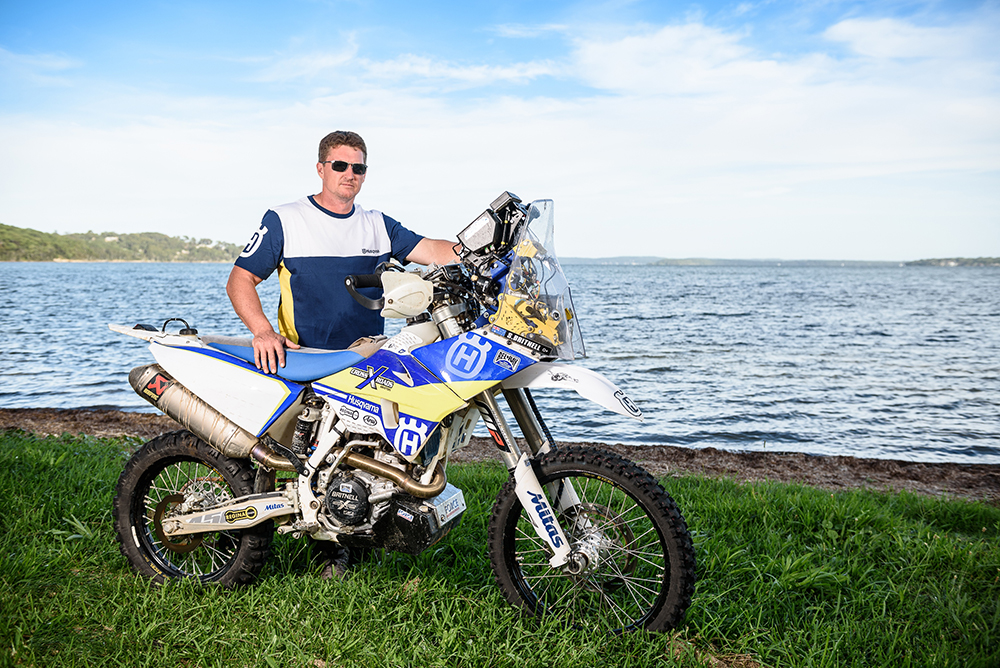
Scott Britnell prepared for the event by riding across Australia
Transplanting the modern Dakar phenomenon into the Arabian Desert in 2020 was only natural, if only because only the Saudis could finance the show. Fortunately they also possessed over two million square kilometres of rugged terrain to satisfy the ASO Course Directors who, in an effort to slow the pace, set the most geographically challenging and technically demanding course since the Dakar departed Africa more than a decade ago.
The ASO has always promoted Dakar as the only premier motorsport event where amateurs could participate alongside the best in the world, at least in the bivouacs. And it’s true. Any Australian that can get hold of a well-prepared bike and get him or herself to Jeddah, can probably get a start for as little as 100 grand, though two-time Dakar finisher Ben Young says there’s no change out of a $140,000 with a professional support package.
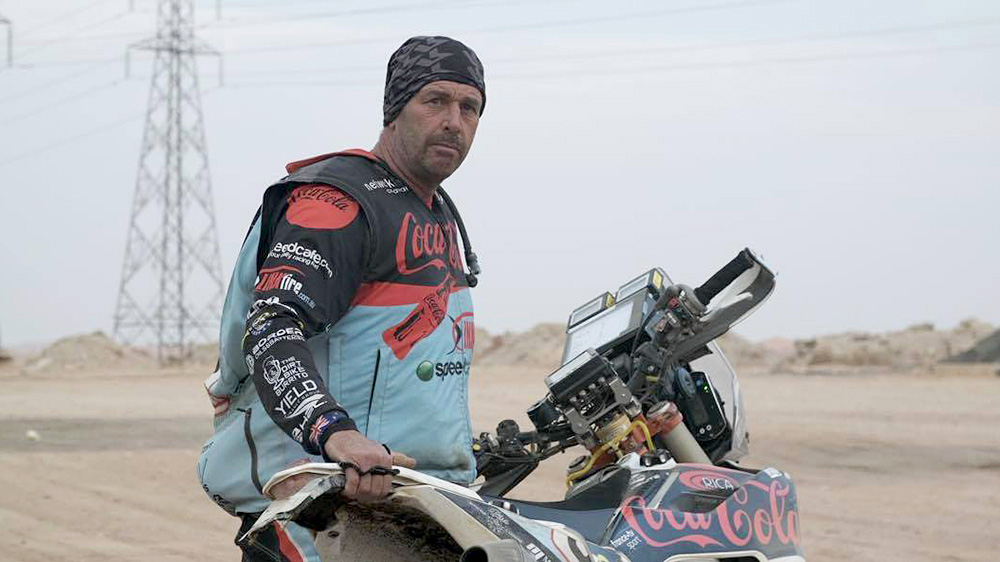
Andrew Houlihan is an unsung Aussie hero
The other entry proviso is that aspiring enthusiasts must prove their ability by completing a qualifying event such as the Abu Dhabi Desert Challenge, or have some other claim to fame such as Warren Strange or Scott Britnell. Depends on your job, but a year off work has to cost at least fifty grand. So entering Dakar and breathing the same air would possibly cost the best part of $200K. And that’s the easy bit. Which is why most Dakar rookies are likely to have already achieved considerable success in life.
Mike Burgess, a Victorian caravan-park proprietor and Andrew Houlihan, a self-employed businessman from NSW, match the profile. Both are family men who have been in business long enough to enjoy the support of local sponsors to defray the cost. Their hobbies include riding, cross-training, adventure riding, keeping fit, more riding and mountain biking. Both have spent enough time in plaster to realise that Dakar is far more likely to put them back in hospital than on the podium accepting a Finisher’s medallion.
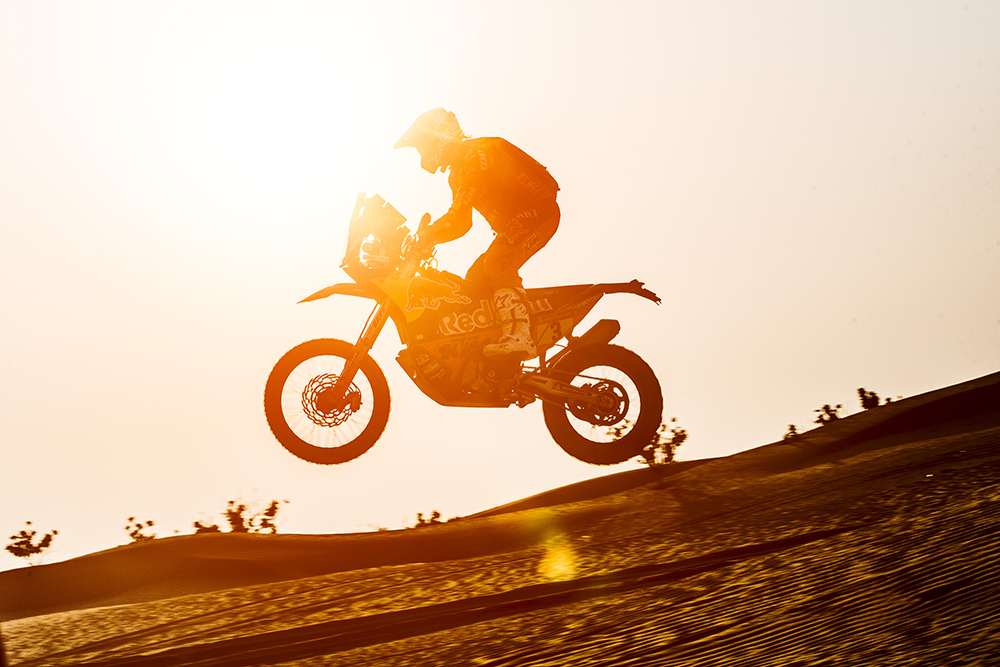
Toby Price stage 5 2021
All either bloke wanted to do was finish and prove something they found it difficult to articulate. Both finished in triumph, Burgess in the top 30 and Houlihan in the top 50, despite breaking the scaphoid in his right wrist on the third stage. At the least he now knows exactly what it takes to set off the new air vests, and how long it takes to fit a new gas cartridge. All valuable experience for 2022.
Were it not for the Australian Off-Road Championships being canned due to Covid-19, Daniel ‘Chucky’ Sanders may have been committed to defending his 2019 title. Instead he received an offer to test for the KTM Factory Rally Team. That he would have got there eventually seems beyond doubt but, at only 26 years old, the timing is perfect. Much comparison is already being made between Chucky and his former AORC teammate Price (and not just their hairstyles), but the only relevant comparison is that both Aussies totally dominated their rookie years.
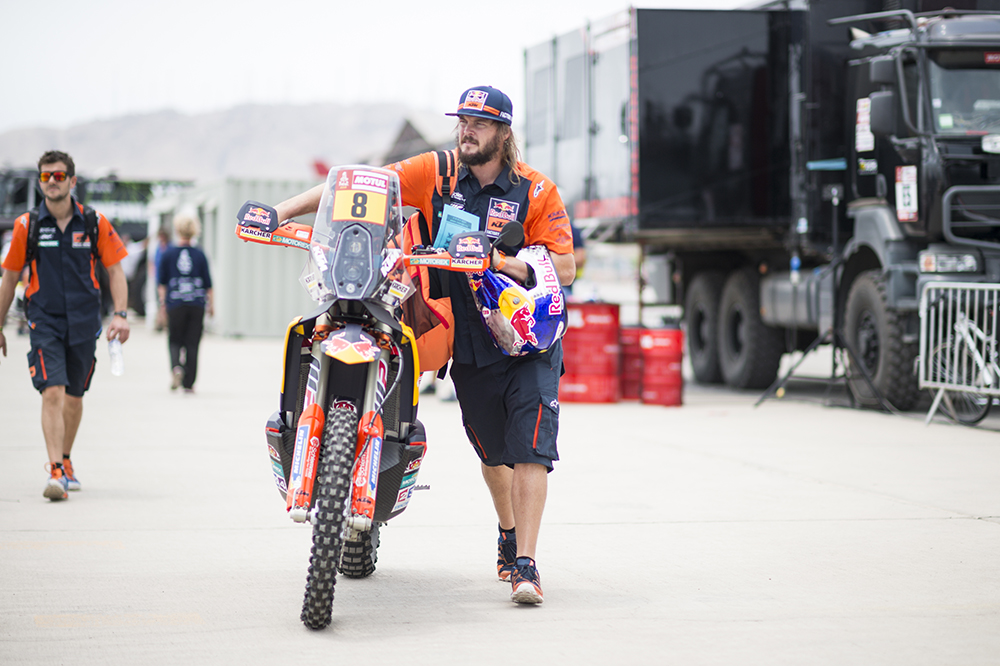
Chucky put in an outstanding performance despite his navigational experience being limited to a single faux cross-country event in Spain. He regularly took up duty as point man without becoming hopelessly disoriented, or at least no more so than far more experienced veterans. And he often set the fastest time between waypoints during the final week.
Yet our popular press made no mention of Chucky’s achievements, instead focussing on Toby’s crash. Forget who won, forget second, third and Chucky’s fourth.
Our only national newspaper posed the question ‘Is Dakar warrior Price the toughest man in Australian sport?’ A rhetorical question at best, but possibly one that has some merit considering the number of injuries Toby has endured in a career spanning two decades.
Notwithstanding his Stage Five crash, Toby is a Dakar hero. He’s now been joined by Chucky, who after 48 hours in the saddle looks set for a long professional rally career.
Having taken over 73 hours to cover the same territory as Chucky, Andrew Houlihan may never feature on the sport pages of the national papers. However having suffered all that Dakar could throw at him for more than one full day longer than the placegetters, he certainly qualifies as one tough Aussie.
